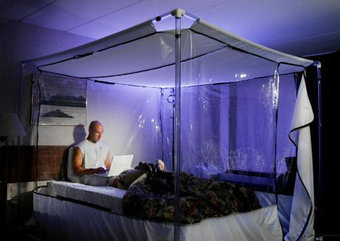In order to get accustomed to playing in the low-oxygen high-altitude environment of South Africa where the 2010 World Cup is going to take place in about two months, English soccer stars are reportedly sleeping in oxygen-deprivation tents.
The players are subjected to a variety of creepy tests at the team’s Hertfordshire “hotel,” which basically sounds like that facility where Drago trained in Rocky IV. That’s fitting, though, because I’ve always imagined the U.S. national team preparing for the World Cup by getting together at a cabin and heaving some big logs around.
At the facility, England’s players ride exercise bikes with masks that limit the amount of oxygen they can breath. Those who huff and puff a little too hard will have the oxygen-deprivation tents delivered to their homes, so they can gradually acclimatize their bodies to low-oxygen, high-altitude conditions. Matches at this summer’s World Cup will take place at heights of up to 5,000 feet above sea level, and the tents can precisely match that altitude with a hypoxic pump that flushes 100 liters of air through the tent every minute.
Sleeping at altitude can prove just as effective as training at altitude and the state-of-the-art equipment can replicate the exact heights of the World Cup venues.
Why does altitude affect performance?
At higher altitudes the air is thinner. Each breath has less oxygen, so you need to work harder to maintain the supply. When less oxygen is delivered to the muscles, fatigue sets in.
How do the tents help?
They stimulate the production of red blood cells, which carry oxygen to the muscles.
So why won’t everyone get them?
England players have already been subjected to altitude testing to determine who needs the most help. Some players’ heart rates will rise as the air gets thinner, but others will have less of a problem.
Source: Daily Mail.





Pingback: Using a rebounder to cleans